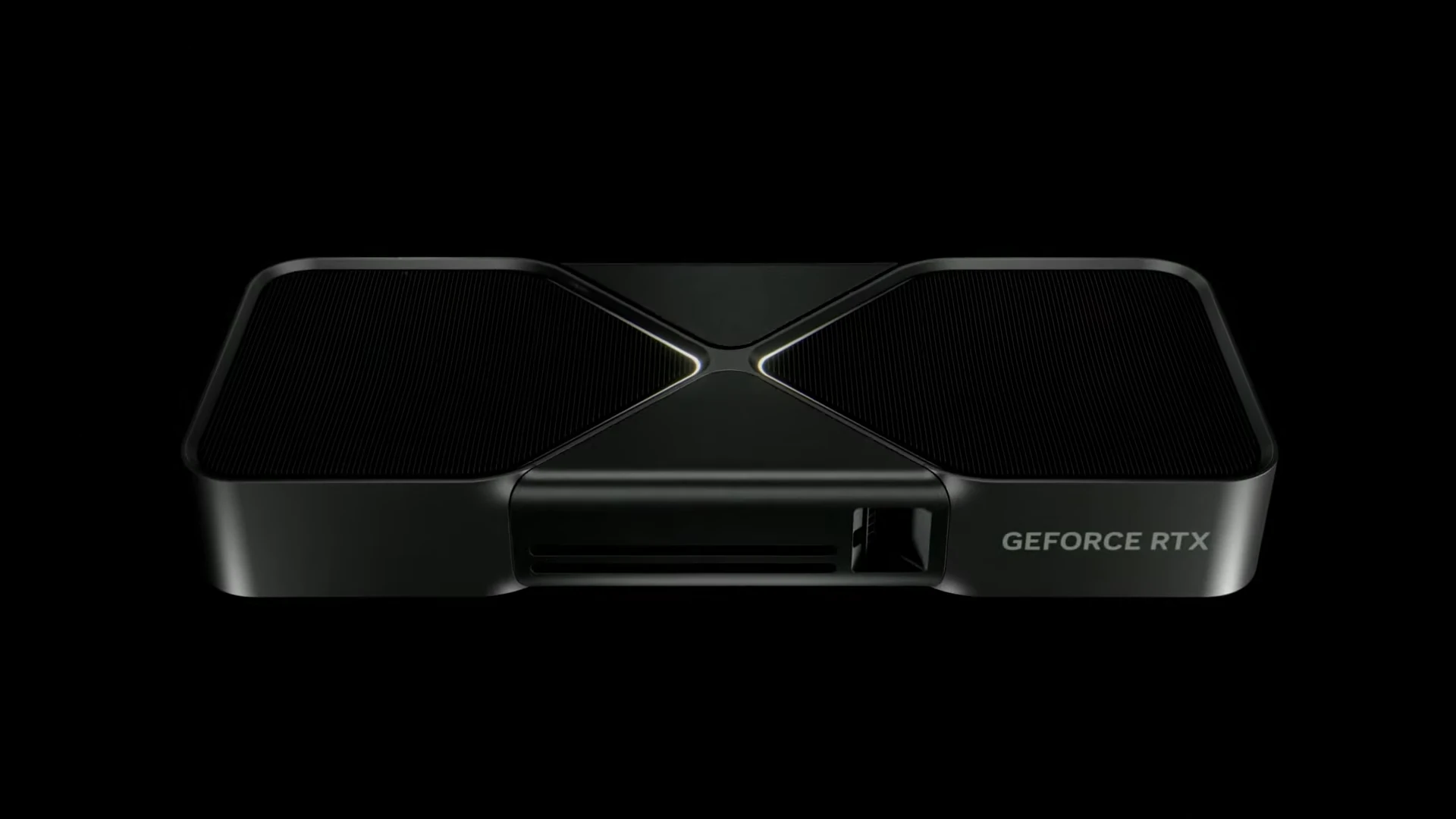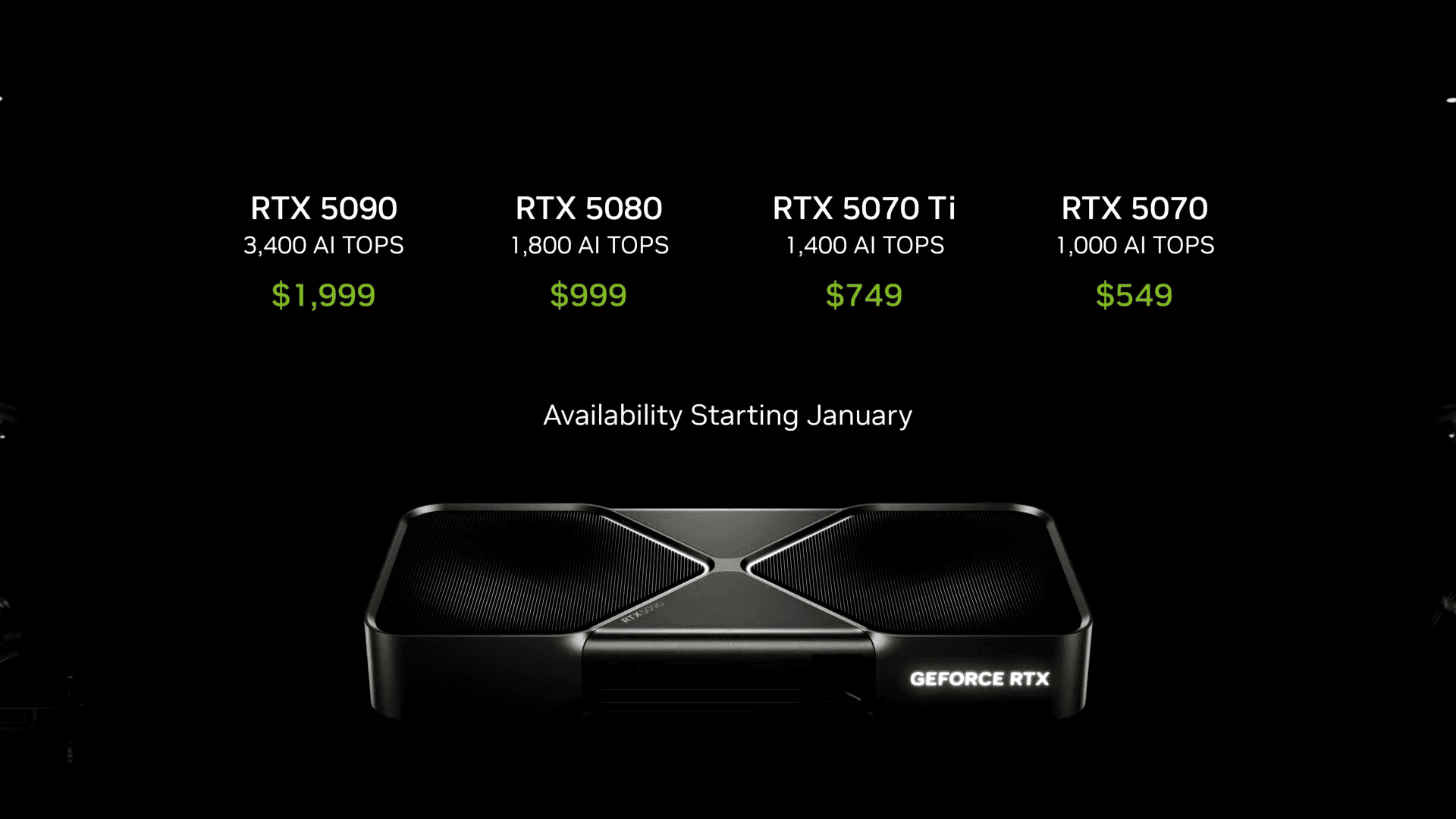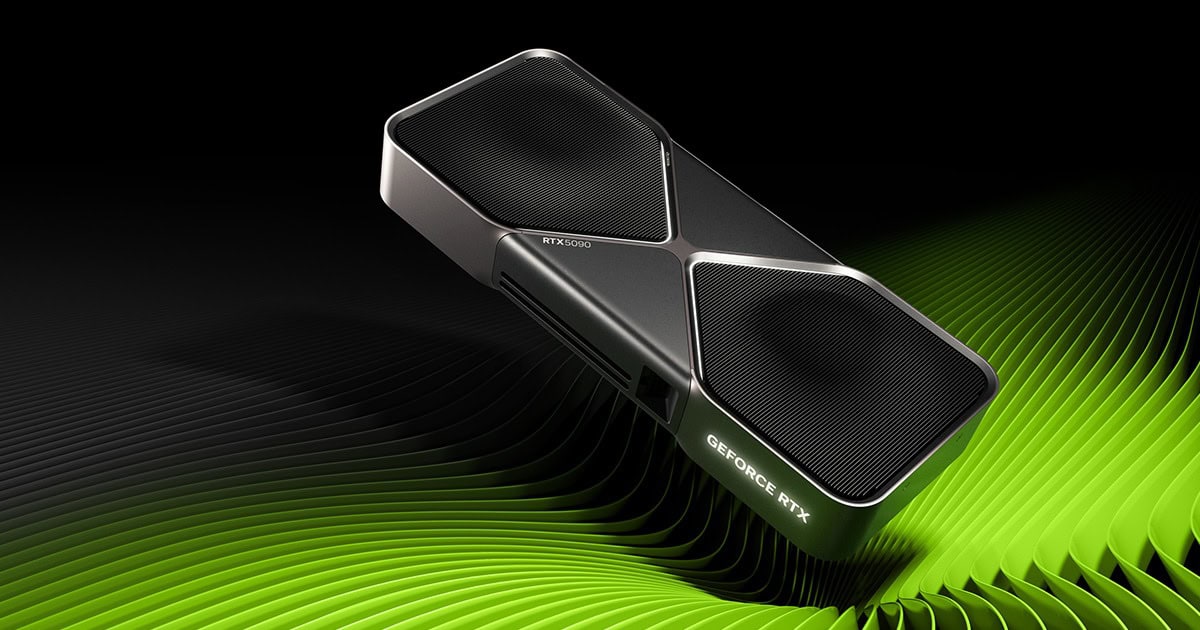Nvidia has unveiled its groundbreaking RTX 50 Series GPUs at CES 2025. The new lineup includes the RTX 5090, RTX 5080, RTX 5070 Ti, and RTX 5070, offering significant performance gains over their predecessors. These graphics cards are built on Nvidia’s cutting-edge Blackwell architecture, promising enhanced ray tracing capabilities and improved AI performance.
The RTX 50 Series introduces several technological advancements. Nvidia claims these GPUs can run creative generative AI models up to twice as fast as the previous generation, while using less memory. The cards also feature ninth-generation Nvidia encoders for advanced video editing and livestreaming, along with support for DLSS 4 technology.
Pricing for the new GPUs ranges from $549 for the RTX 5070 to $1,999 for the flagship RTX 5090. These cards aim to deliver game-changing performance for gaming, AI experiences, and creative workflows. With up to 32GB of VRAM available on some models, the RTX 50 Series is poised to handle demanding tasks across various applications.

The Aftermath of the RTX 50 Series Launch: What’s Next?
| Card | Release Date | Price | VRAM | CUDA Cores | Memory Bandwidth (GB/s) | Total Graphics Power (W) |
|---|---|---|---|---|---|---|
| RTX 5090 | January 30th, 2025 | $1,999 | 32GB GDDR7 | 21,760 | 1,792 | 575 |
| RTX 5080 | January 30th, 2025 | $999 | 16GB GDDR7 | 10,752 | 960 | 360 |
| RTX 5070 Ti | February 2025 | $749 | 16GB GDDR7 | 8,960 | 896 | 300 |
| RTX 5070 | February 2025 | $549 | 12GB GDDR7 | 6,144 | 672 | 250 |
Performance Expectations
Nvidia’s claims about the RTX 50 series, particularly the 5070’s potential to match the 4090’s performance, have set high expectations. Independent benchmarks will be crucial in verifying these claims and providing a realistic picture of the cards’ capabilities across different games and resolutions.
DLSS 4 Adoption
The success of DLSS 4 will heavily influence the 50 series’ overall impact. Game developers will need to integrate and optimize DLSS 4 into their games to fully utilize its potential. Wider adoption of DLSS 4 could lead to a significant shift in how games are rendered and experienced.

Competition from AMD
AMD, Nvidia’s main competitor in the GPU market, is likely to respond with its own next-generation offerings. The competition between the two companies could drive further innovation and price reductions, benefiting consumers.
Impact on the Used GPU Market
The release of the 50 series is expected to cause a ripple effect in the used GPU market. Prices of previous-generation cards, especially the 40 series, are likely to drop as gamers upgrade to the latest technology. This could present an opportunity for budget-conscious buyers to acquire powerful GPUs at lower prices.
The Future of AI in Graphics
The 50 series emphasizes the growing role of AI in graphics technology. We can expect to see further advancements in AI-powered features like DLSS, ray tracing, and image enhancement in future generations of GPUs.
Supply and Demand

The initial availability of the 50 series cards remains to be seen. If previous launches are any indication, there could be supply constraints and high demand, leading to increased prices and limited availability in the early stages.
Price Adjustments
Nvidia will likely not adjust the prices of the 50 series cards because market demand, competition, and production costs will sell out all the founders edition stock right away. It’s not uncommon for GPU prices to fluctuate after launch on 3rd-party models so keeping an eye on the market is advisable.
As usual with any Nvidia GPU launch, there’s a chance all the stock at MSRP will sell out quickly and a very robust secondary market (with very high markups) will sprout up. Be prepared to pay above MSRP if you absolutely want to get your hands on an RTX 50 series card – or consider going with an AMD 9000 series or Intel Battlemage card if that suits your need.
Software and Driver Updates
Nvidia will continue to release software and driver updates to optimize the performance of the 50 series cards and address any potential issues. These updates can significantly impact gaming experiences, so staying up-to-date is essential.
Community Feedback
The gaming community’s feedback on the 50 series will play a role in shaping its long-term success. Reviews, user experiences, and community discussions will provide valuable insights into the cards’ strengths and weaknesses.
Long-Term Implications
The RTX 50 series represents a significant step forward in graphics technology. Its long-term implications could include more accessible high-fidelity gaming, increased adoption of AI-powered features, and a shift towards more efficient rendering techniques.
More Technical Details

Here’s some additional information for those who want a deeper dive into the specs:
- Founders Edition Dimensions:
- RTX 5090/5080: 304mm L x 137mm H (2-slot)
- RTX 5070 Ti: 242mm L x 112mm H (2-slot)
- AI Performance (TOPS):
- RTX 5090: 3400 TOPS
- RTX 5080: 1800 TOPS
- RTX 5070 Ti: 1400 TOPS
- RTX 5070: 1000 TOPS
- NVENC Encoder: All cards feature 9th generation NVENC encoders for improved video encoding performance.
New Features for Gamers
Nvidia also announced some exciting new features:
- Reflex 2: This technology combines Reflex Low Latency mode with Frame Warp to further reduce system latency, resulting in even more responsive gameplay.
- Project G-Assist: A voice-powered AI assistant that can optimize game settings, monitor performance, and even help troubleshoot issues.
Advancements for Creators
Content creators will benefit from these advancements:
- Enhanced Encoding/Decoding: The 50 series offers improved hardware support for the 4:2:2 color format, significantly speeding up video encoding for professional workflows.
- RTX Neural Shaders: These AI-powered shaders enable more realistic materials, lighting, and effects in real-time, pushing the boundaries of visual fidelity.
The Potential Impact on Esports
The RTX 50 series could significantly impact the esports landscape. The increased performance and features like DLSS 4 could lead to higher frame rates, smoother gameplay, and improved visual fidelity in competitive titles. This could give professional gamers a competitive edge and enhance the viewing experience for esports audiences. Additionally, the 50 series’ AI-powered features could enable new forms of esports content creation and analysis, further pushing the boundaries of competitive gaming.
Key Takeaways
- Nvidia’s RTX 50 Series GPUs offer significant performance improvements for gaming, AI, and creative tasks
- The new lineup includes models ranging from $549 to $1,999, catering to different user needs and budgets
- Advanced features like DLSS 4 and improved AI model performance set these GPUs apart from previous generations
Technical Innovations and Performance
Nvidia’s RTX 50 Series GPUs bring groundbreaking advancements in graphics processing and AI capabilities. These new cards offer significant performance gains and introduce cutting-edge technologies that redefine gaming and creative workflows.
Revolutionary Blackwell Architecture
The RTX 50 Series is built on Nvidia’s new Blackwell architecture. This design marks a major leap forward in GPU technology. Blackwell introduces fifth-generation Tensor Cores, dramatically improving AI performance. The architecture enables up to 40% better power efficiency in laptops.
Blackwell GPUs feature enhanced FP4 precision, boosting AI model training and inference. This improvement allows for faster processing of complex AI workloads. The architecture also incorporates advanced memory subsystems, supporting GDDR7 memory with increased bandwidth.
The RTX 5090 boasts impressive specifications. It features a 512-bit memory interface and delivers substantial gains in AI TOPS (Trillions of Operations Per Second). These enhancements position the RTX 50 Series as a powerhouse for both gaming and AI applications.
Enhancements in Graphics Processing
RTX 50 Series GPUs offer significant upgrades in raw graphics performance. The cards feature increased CUDA core counts, enabling faster rendering and more detailed visuals. Compared to the previous RTX 4090 and 4080, the new models show notable improvements in frame rates across various resolutions.
Memory bandwidth sees a substantial boost with GDDR7 implementation. This increase allows for smoother handling of high-resolution textures and complex scenes. The RTX 5090 and 5080 models particularly benefit from this upgrade, offering enhanced 4K and 8K gaming experiences.
Nvidia has also improved the cards’ ray tracing capabilities. The new GPUs can handle more ray-traced effects simultaneously, resulting in more realistic lighting, shadows, and reflections in games and 3D applications.
Advancements in Ray Tracing and AI-Driven Rendering
The RTX 50 Series introduces RTX Neural Shaders, a technology that combines ray tracing with AI-driven rendering. This innovation allows for more efficient creation of realistic graphics. Neural shaders can generate complex visual effects with less computational overhead.
Ray reconstruction techniques have been refined in this generation. The GPUs can now process and reconstruct ray-traced scenes more quickly and accurately. This improvement leads to smoother frame rates in games with intensive ray-traced effects.
AI-driven rendering sees significant enhancements. The new GPUs can handle more AI operations per second, enabling faster and more sophisticated real-time graphics processing. This capability extends to creative applications, accelerating tasks like 3D modeling and video editing.
DLSS 4 and Super Resolution Technologies
DLSS 4 represents a major evolution in Nvidia’s AI-powered upscaling technology. It utilizes a new DLSS Transformer engine, which improves image quality and performance. DLSS 4 can generate higher quality frames with less artifacts, even at lower native resolutions.
The technology now incorporates multi-frame generation. This feature allows the GPU to create multiple high-quality frames simultaneously, further boosting performance in supported games. DLSS 4 also enhances super resolution capabilities, providing sharper and more detailed images.
RTX Neural Faces, another AI-powered feature, improves character rendering in games and applications. It enables more realistic facial animations and expressions, enhancing overall visual fidelity. These advancements collectively push the boundaries of real-time graphics and AI-assisted rendering.
Frequently Asked Questions
Nvidia’s RTX 50 series GPUs have generated significant interest. These new graphics cards promise performance improvements, innovative features, and competitive pricing.
What are the expected performance improvements of the RTX 5080 over its predecessors?
The RTX 5080 is anticipated to offer substantial performance gains over previous generations. Preliminary reports suggest up to 2x faster performance in creative tasks and AI workloads compared to its predecessor.
NVIDIA DLSS 4 technology may boost frame rates by up to 8x in supported games. This represents a significant leap in gaming performance for the RTX 5080.
What is the anticipated pricing structure for the Nvidia RTX 50 series GPUs?
Nvidia has announced pricing for several models in the RTX 50 series lineup:
- RTX 5090: $1,999
- RTX 5080: $999
- RTX 5070 Ti: $749
- RTX 5070: $549
These prices position the new GPUs competitively within the high-end graphics card market.
When is the expected release date for the Nvidia RTX 5070 and 5090 models?
Nvidia has not provided specific release dates for the RTX 5070 and 5090 models. The announcement at CES 2025 suggests these GPUs will likely become available in the first half of 2025.
Exact launch dates may vary by region and retailer. Nvidia typically staggers releases of different models over several months.
Has there been an official announcement regarding the Nvidia RTX 50 series GPUs?
Yes, Nvidia officially announced the RTX 50 series GPUs at CES 2025. CEO Jensen Huang unveiled the new lineup during a keynote presentation.
The announcement covered key features, performance targets, and pricing for several models in the RTX 50 series.
What features can be anticipated with the introduction of the RTX 50 series graphics cards?
The RTX 50 series introduces several new features:
- NVIDIA Blackwell architecture
- Fifth-generation Tensor Cores
- DLSS 4 with Multi Frame Generation
- NVIDIA Reflex 2 for reduced latency
- RTX Neural Shaders for improved graphical fidelity
- Ninth-generation NVIDIA encoders for video editing and streaming
These cards also offer up to 32GB of VRAM, catering to demanding creative and gaming applications.
How does the RTX 5000 series compare to the previous Nvidia 40 series in terms of capabilities?
The RTX 50 series offers significant improvements over the 40 series:
- Faster AI and creative workload processing (up to 2x)
- Enhanced gaming performance with DLSS 4
- Lower latency with NVIDIA Reflex 2 (up to 75% reduction)
- Improved video encoding capabilities
The new Blackwell architecture provides a foundation for these advancements, enabling better performance across various applications.







